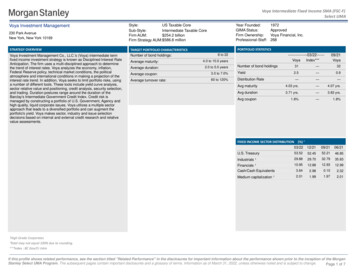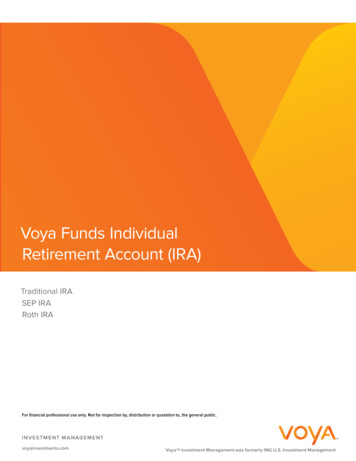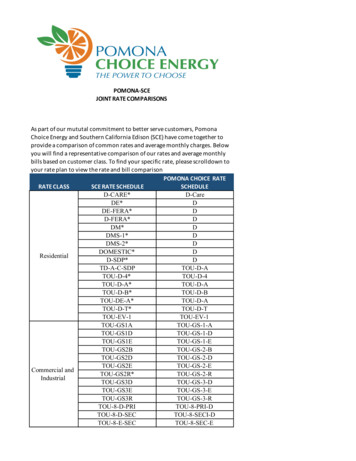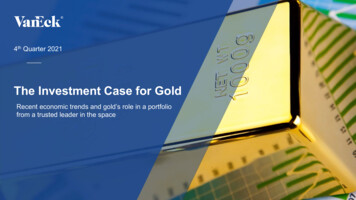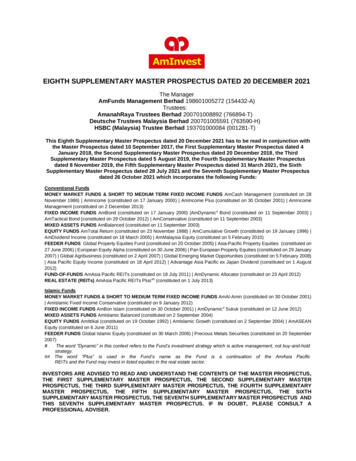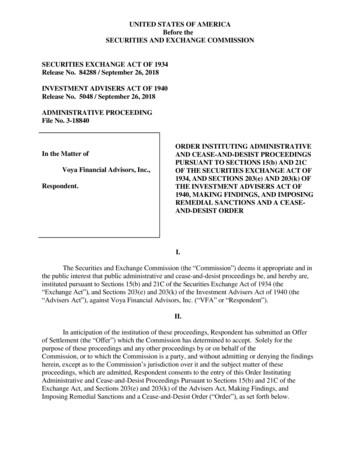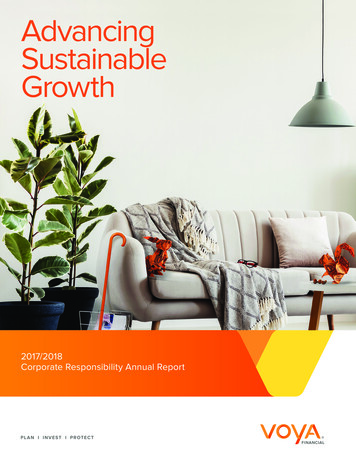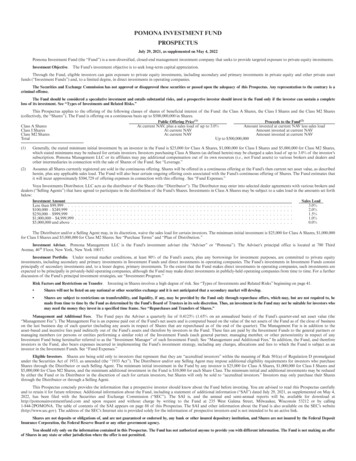
Transcription
POMONA INVESTMENT FUNDPROSPECTUSJuly 29, 2021, as supplemented on May 4, 2022Pomona Investment Fund (the “Fund”) is a non-diversified, closed-end management investment company that seeks to provide targeted exposure to private equity investments.Investment Objective.The Fund’s investment objective is to seek long-term capital appreciation.Through the Fund, eligible investors can gain exposure to private equity investments, including secondary and primary investments in private equity and other private assetfunds (“Investment Funds”) and, to a limited degree, in direct investments in operating companies.The Securities and Exchange Commission has not approved or disapproved these securities or passed upon the adequacy of this Prospectus. Any representation to the contrary is acriminal offense.The Fund should be considered a speculative investment and entails substantial risks, and a prospective investor should invest in the Fund only if the investor can sustain a completeloss of its investment. See “Types of Investments and Related Risks.”This Prospectus applies to the offering of the following classes of shares of beneficial interest of the Fund: the Class A Shares, the Class I Shares and the Class M2 Shares(collectively, the “Shares”). The Fund is offering on a continuous basis up to 500,000,000 in Shares.Public Offering Price(1)Proceeds to the Fund(2)Class A SharesAt current NAV, plus a sales load of up to 3.0%Amount invested at current NAV less sales loadClass I SharesAt current NAVAmount invested at current NAVClass M2 SharesAt current NAVAmount invested at current NAVTotalUp to 500,000,000(1)Generally, the stated minimum initial investment by an investor in the Fund is 25,000 for Class A Shares, 1,000,000 for Class I Shares and 5,000,000 for Class M2 Shares,which stated minimums may be reduced for certain investors. Investors purchasing Class A Shares (as defined herein) may be charged a sales load of up to 3.0% of the investor’ssubscription. Pomona Management LLC or its affiliates may pay additional compensation out of its own resources (i.e., not Fund assets) to various brokers and dealers andother intermediaries in connection with the sale of Shares of the Fund. See “Leverage.”(2)Assumes all Shares currently registered are sold in the continuous offering. Shares will be offered in a continuous offering at the Fund’s then current net asset value, as describedherein, plus any applicable sales load. The Fund will also bear certain ongoing offering costs associated with the Fund’s continuous offering of Shares. The Fund estimates thatit will incur approximately 304,729 of offering expenses in connection with this offering . See “Fund Expenses.”Voya Investments Distributor, LLC acts as the distributor of the Shares (the “Distributor”). The Distributor may enter into selected dealer agreements with various brokers anddealers (“Selling Agents”) that have agreed to participate in the distribution of the Fund’s Shares. Investments in Class A Shares may be subject to a sales load in the amounts set forthbelow:Investment AmountSales LoadLess than 99,999 . . . . . . . . . . . . . . . . . . . . . . . . . . . . . . . . . . . . . . . . . . . . . . . . . . . . . . . . . . . . . . . . . .3.0% 100,000 – 249,999 . . . . . . . . . . . . . . . . . . . . . . . . . . . . . . . . . . . . . . . . . . . . . . . . . . . . . . . . . . . . . . . .2.0% 250,000 – 999,999 . . . . . . . . . . . . . . . . . . . . . . . . . . . . . . . . . . . . . . . . . . . . . . . . . . . . . . . . . . . . . . . .1.5% 1,000,000 – 4,999,999 . . . . . . . . . . . . . . . . . . . . . . . . . . . . . . . . . . . . . . . . . . . . . . . . . . . . . . . . . . . . . . .1.0% 5,000,000 and above . . . . . . . . . . . . . . . . . . . . . . . . . . . . . . . . . . . . . . . . . . . . . . . . . . . . . . . . . . . . . . . .0.0%The Distributor and/or a Selling Agent may, in its discretion, waive the sales load for certain investors. The minimum initial investment is 25,000 for Class A Shares, 1,000,000for Class I Shares and 5,000,000 for Class M2 Shares. See “Purchase Terms” and “Plan of Distribution.”Investment Adviser. Pomona Management LLC is the Fund’s investment adviser (the “Adviser” or “Pomona”). The Adviser’s principal office is located at 780 ThirdAvenue, 46th Floor, New York, New York 10017.Investment Portfolio. Under normal market conditions, at least 80% of the Fund’s assets, plus any borrowings for investment purposes, are committed to private equityinvestments, including secondary and primary investments in Investment Funds and direct investments in operating companies. The Fund’s investments in Investment Funds consistprincipally of secondary investments and, to a lesser degree, primary investments. To the extent that the Fund makes direct investments in operating companies, such investments areexpected to be principally in privately-held operating companies, although the Fund may make direct investments in publicly-held operating companies from time to time. For a furtherdiscussion of the Fund’s principal investment strategies, see “Investment Program.”Risk Factors and Restrictions on Transfer.Investing in Shares involves a high degree of risk. See “Types of Investments and Related Risks” beginning on page 41. Shares will not be listed on any national or other securities exchange and it is not anticipated that a secondary market will develop. Shares are subject to restrictions on transferability, and liquidity, if any, may be provided by the Fund only through repurchase offers, which may, but are not required to, bemade from time to time by the Fund as determined by the Fund’s Board of Trustees in its sole discretion. Thus, an investment in the Fund may not be suitable for investors whomay need the money they invest in a specified time frame. See “Repurchases and Transfers of Shares.”Management and Additional Fees. The Fund pays the Adviser a quarterly fee of 0.4125% (1.65% on an annualized basis) of the Fund’s quarter-end net asset value (the“Management Fee”). The Management Fee is an expense paid out of the Fund’s net assets and is computed based on the value of the net assets of the Fund as of the close of businesson the last business day of each quarter (including any assets in respect of Shares that are repurchased as of the end of the quarter). The Management Fee is in addition to theasset-based and incentive fees paid indirectly out of the Fund’s assets and therefore by investors in the Fund. These fees are paid by the Investment Funds to the general partners ormanaging members (or persons or entities performing a similar role) of the Investment Funds (such general partner, managing member, or other person/entity in respect of anyInvestment Fund being hereinafter referred to as the “Investment Manager” of such Investment Fund). See “Management and Additional Fees.” In addition, the Fund, and thereforeinvestors in the Fund, also bears expenses incurred in implementing the Fund’s investment strategy, including any charges, allocations and fees to which the Fund is subject as aninvestor in the Investment Funds. See “Fund Expenses.”Eligible Investors. Shares are being sold only to investors that represent that they are “accredited investors” within the meaning of Rule 501(a) of Regulation D promulgatedunder the Securities Act of 1933, as amended (the “1933 Act”). The Distributor and/or any Selling Agent may impose additional eligibility requirements for investors who purchaseShares through the Distributor or such Selling Agent. The minimum initial investment in the Fund by any investor is 25,000 for Class A Shares, 1,000,000 for Class I Shares and 5,000,000 for Class M2 Shares, and the minimum additional investment in the Fund is 10,000 for each Share Class. The minimum initial and additional investments may be reducedby either the Fund or its Distributor in the discretion of each for certain investors, but Shares will only be sold to “accredited investors.” Investors may only purchase their Sharesthrough the Distributor or through a Selling Agent.This Prospectus concisely provides the information that a prospective investor should know about the Fund before investing. You are advised to read this Prospectus carefullyand to retain it for future reference. Additional information about the Fund, including a statement of additional information (“SAI”) dated July 29, 2021, as supplemented on May 4,2022, has been filed with the Securities and Exchange Commission (“SEC”). The SAI is, and the annual and semi-annual reports will be, available for download athttp://pomonainvestmentfund.com and upon request and without charge by writing to the Fund at 235 West Galena Street, Milwaukee, Wisconsin 53212 or by calling1-844-2POMONA. The table of contents of the SAI appears on page 88 of this Prospectus. The SAI and other information about the Fund is also available on the SEC’s website(http://www.sec.gov). The address of the SEC’s Internet site is provided solely for the information of prospective investors and is not intended to be an active link.Shares are not deposits or obligations of, and are not guaranteed or endorsed by, any bank or other insured depository institution, and Shares are not insured by the Federal DepositInsurance Corporation, the Federal Reserve Board or any other government agency.You should rely only on the information contained in this Prospectus. The Fund has not authorized anyone to provide you with different information. The Fund is not making an offerof Shares in any state or other jurisdiction where the offer is not permitted.
IMPORTANT NOTICE TO SHAREHOLDERSBeginning on January 1, 2021, pursuant to regulations adopted by the Securities and Exchange Commission, paper copies of the Pomona Investment Fund’s shareholderreports, like this one, will no longer be sent by mail, unless you specifically request paper copies of the reports from the Fund. Instead, the reports will be made available on the Fund’swebsite and you will be notified by mail each time a report is posted and provided with a website link to access the report.If you already elected to receive shareholder reports electronically, you will not be affected by this change and you need not take any action. You may elect to receive papercopies of shareholder reports and other communications from the Fund by requesting such information in writing to the Fund at 780 Third Avenue, 46th Floor, New York, NY 10017,or by calling tollfree at 1-(844)-2POMONA. If you own your shares through a financial intermediary (such as a broker-dealer or bank) you must contact your financial intermediary.You may elect to receive all future reports in paper free of charge. You can inform the Fund or your financial intermediary that you wish to continue receiving paper copies ofyour shareholder reports by contacting them directly. Your election to receive reports in paper will apply to the Fund and all funds held through your financial intermediary, asapplicable.Voya Investments Distributor, LLC
TABLE OF CONTENTSSUMMARY OF TERMS . . . . . . . . . . . . . . . . . . . . . . . . . . . . . . . . . . . . . . . . . . . . . . . . . .SUMMARY OF FEES AND EXPENSESSENIOR SECURITIES . . . . . . . . . . . . .FINANCIAL HIGHLIGHTS . . . . . . . . .THE FUND . . . . . . . . . . . . . . . . . . . . .USE OF PROCEEDS . . . . . . . . . . . . . . .STRUCTURE . . . . . . . . . . . . . . . . . . . .INVESTMENT PROGRAM . . . . . . . . . .30323333333334TYPES OF INVESTMENTS AND RELATED RISKS . . . . . . . . . . . . . . . . . . . . . . . . . . . . .LIMITS OF RISK DISCLOSURES . . . . . . . . . . . . . . . . . . . . . . . . . . . . . . . . . . . . . . . . . . .4156MANAGEMENT OF THE FUND . . . . . . . . . . . . . . . . . . . . . . . . . . . . . . . . .FUND EXPENSES . . . . . . . . . . . . . . . . . . . . . . . . . . . . . . . . . . . . . . . . . . . .MANAGEMENT AND ADDITIONAL FEES, ADMINISTRATION FEE ANDSUB-ADMINISTRATION FEE . . . . . . . . . . . . . . . . . . . . . . . . . . . . . . . . .CALCULATION OF NET ASSET VALUE . . . . . . . . . . . . . . . . . . . . . . . . . . .CONFLICTS OF INTEREST . . . . . . . . . . . . . . . . . . . . . . . . . . . . . . . . . . . . .PURCHASES OF SHARES . . . . . . . . . . . . . . . . . . . . . . . . . . . . . . . . . . . . . .REPURCHASES AND TRANSFERS OF SHARES . . . . . . . . . . . . . . . . . . . . .5759.6161636670VOTING . . . . . . . . . . . . . . .TAX MATTERS . . . . . . . . .ERISA CONSIDERATIONSPLAN OF DISTRIBUTION .1.73738283DESCRIPTION OF SHARES . . . . . . . . . . . . .DIVIDENDS AND DISTRIBUTIONS . . . . . .MORE INFORMATION ABOUT THE FUNDINQUIRIES . . . . . . . . . . . . . . . . . . . . . . . . .84858787TABLE OF CONTENTS OF THE SAI . . . . . . . . . . . . . . . . . . . . . . . . . . . . . . . . . . . . . . . .88i
SUMMARY OF TERMSTHE FUND . . . . . . . . . . . . . . . .Pomona Investment Fund (the “Fund”) is a non-diversified,closed-end management investment company that seeks toprovide eligible investors with targeted exposure to private equityinvestments. The Fund’s investment adviser is PomonaManagement LLC (the “Adviser” or “Pomona”).The Fund seeks to provide access to investments that are generallyunavailable to the investing public due to investor suitabilityrestrictions, resource and operational requirements, and higherinvestment minimums. Accordingly, the Fund has been structuredwith the intent of providing exposure and streamlining access toprivate equity investing. Through the Fund, eligible investors cangain exposure to the potential rewards of private equityinvestments through a registered fund that is structured tofacilitate investing in this asset class without being required to, forexample, manage the funding of capital calls on short notice, meetlarge minimum commitment amounts, or receive complex taxreporting on Internal Revenue Service (“IRS”) Form 1065,Schedule K-1s.Through the Fund, investors have access to private equityinvestments, including secondary and primary investments (asdefined more fully below) in private equity and other private assetfunds (“Investment Funds”) that may otherwise restrict thenumber and type of persons whose money will be accepted forinvestment. These Investment Funds are unaffiliated with, andnot related to, the Fund or the Adviser. Investing in the Fund alsopermits eligible individual and institutional investors(“Shareholders”) to invest in Investment Funds without beingsubject to the high minimum investment requirements imposed oninvestors in such Investment Funds, which the Adviser believestypically range between 5 million and 20 million. In addition,because the Fund intends to qualify as a “regulated investmentcompany” (“RIC”) under Subchapter M of the Internal RevenueCode of 1986, as amended (the “Code”), it is expected to havecertain attributes that are not generally found in traditionalunregistered private equity fund of funds. These include providingsimpler tax reports to Shareholders on Form 1099 and theavoidance of unrelated business taxable income for benefit planinvestors and other investors that are exempt from payments ofU.S. federal income tax.The Fund commenced operations on May 7, 2015. An affiliate ofPomona provided the initial capitalization of 50 million to theFund prior to commencement of operations.INVESTMENT OBJECTIVE . . .The Fund’s investment objective is to seek long-term capitalappreciation.INVESTMENT PROGRAM . . . .The Fund seeks long-term capital appreciation by investingprimarily in private equity investments. The Fund investsprincipally in secondary investments in Investment Funds and, toa lesser degree, in primary investments in Investment Funds. TheFund may also invest in direct investments in operatingcompanies. Under normal market conditions, at least 80% of itsassets, plus any borrowings for investment purposes, are1
committed to these types of private equity investments. TheFund’s investments in Investment Funds consist principally ofsecondary investments and, to a lesser degree, primaryinvestments. To the extent the Fund makes direct investments inoperating companies, such investments are expected to beprincipally in privately-held operating companies, although theFund may make direct investments in publicly-held operatingcompanies from time to time.Each underlying Investment Fund is, or will be, managed by thegeneral partner or managing member (or a person or entityperforming a similar role) of the Investment Fund (such generalpartner, managing member, or other person/entity in respect ofany Investment Fund being hereinafter referred to as the“Investment Manager” of such Investment Fund) under thedirection of the portfolio managers or investment teams selectedby the Investment Manager.By focusing a substantial portion of the Fund’s investmentprogram on secondary interests and seasoned primaryinvestments, the Fund will seek to mitigate the impact of“J-curve” performance (as described below) on the Fund’sreturns, which typically impacts primary investments more sothan secondary investments and seasoned primary investments,potentially increasing interim returns and cash flow. Secondaryinvestments and, to a lesser extent, seasoned primary investmentsmay also mitigate return volatility by increasing the breadth ofinvestments in the Fund’s portfolio, with correspondingbroad-based exposure to existing, rather than blind pool,investments.In pursuing the Fund’s investment objective, the Adviser will seekto invest in Investment Funds and direct investments representinga broad spectrum of types of private equity opportunities (e.g.,buyout, growth capital, special situations, credit, venture capital,private infrastructure, real estate, real assets, and/or other privateassets) and vintage years (i.e., the year in which an InvestmentFund begins investing). The Fund’s investment program isintended to achieve broader investment exposure and moreefficient capital deployment than most eligible investors couldachieve by making a limited number of primary investments inInvestment Funds alone. The Fund will seek to avoidconcentration in any particular industry sector.To maintain liquidity and to meet Investment Fund capital calls,the Fund may invest in short- and medium-term fixed incomesecurities and may hold cash and cash equivalents. The Fund mayalso invest in private investment funds and other securities thatseek to replicate the returns of a theoretical investment in adiversified portfolio of private equity investments. Specifically,Index-Related Investments seek to replicate the performance of adiversified portfolio of private equity investments by investing in aportfolio of publicly traded assets, which may include equities,options, exchange-traded funds (“ETFs”) and futures. The Fundmay use derivative instruments, primarily equity options, forhedging purposes in connection with its investments in one ormore Index-Related Investments.2
In addition to the foregoing, the Fund may utilize a revolvingcredit facility to satisfy repurchase requests from Shareholders, tomeet capital calls, and to otherwise provide the Fund withtemporary liquidity. Finally, the Fund may, to a lesser extent,invest in ETFs designed to track equity indices and listed privateequity vehicles, such as business development companies andpublicly traded private equity firms (“Listed Private Equity”).THE ADVISER . . . . . . . . . . . . .Founded more than 25 years ago, the Adviser is a global,value-oriented private equity firm specializing in investing acrossthe private equity spectrum. The Adviser aims to generateattractive investment returns by following a consistent disciplinedstrategy, focusing relentlessly on quality and investing prudentlyand patiently, to drive consistent growth and returns over a longperiod of time, through multiple market cycles.Headquartered in New York City with offices in London andHong Kong, the Adviser has a team of over 40 professionals as ofJuly 28, 2021, that manages a private equity program ofapproximately 14.3 billion in committed capital, as well asinvestments made on behalf of discretionary separate accountsand by non-discretionary account clients, for over 350sophisticated investors from more than 20 countries. The Adviseris led by a senior management team that has worked togethersince 1995 and is one of the pioneers of investing in secondaryinterests in Investment Funds. The Adviser manages a series ofprivate equity funds that make secondary, primary, and directinvestments, with interests in over 600 diversified InvestmentFunds and more than 8,500 operating companies.PRIVATE EQUITYSTRATEGIES . . . . . . . . . . . . . .Private equity is an asset class typically consisting of equitysecurities and debt in operating companies that are not publiclytraded on a stock exchange. Private equity consists of investorsand funds that typically make investments directly into privatecompanies or conduct buyouts of public companies that typicallyresult in a delisting of public equity. Investment Funds aretypically structured as 10 year partnerships, where capital is calledand investments are made in years 1-4 and sold in years 5-10.For example, general buyout funds seek to acquire private andpublic companies, as well as divisions of larger companies, andreposition them for sale at a multiple of invested equity byunlocking value and enhancing opportunities through financial,managerial, and/or operational improvements.Types of private equity investments that the Fund may makeinclude:Secondary Investments. Secondary investments, or “secondaries,”refer to investments in existing Investment Funds that aretypically acquired in privately negotiated transactions. The privateequity secondary market refers to the buying and selling ofpre-existing investor commitments to private equity and otheralternative investment funds. A seller of a private equityinvestment sells not only the investments in the fund, but also itsremaining unfunded commitments to the fund. When purchasing3
a secondary, the buyer will agree to purchase an investor’s existinglimited partnership position in an Investment Fund, typically at adiscount to net asset value, and take on existing obligations tofund future capital calls. Secondary transactions are typicallypurchases of Investment Funds that are three to seven years old,with existing portfolio companies. These types of private equityinvestments are viewed as more mature investments thanprimaries and, as a result, the investment returns from theseinvestments may not exhibit, or may exhibit to a lesser degree, thedelayed cash flow and return “J-curve” performance (as describedbelow) that is normally associated with primary investments. Inaddition, secondaries typically have a shorter duration thanprimary investments, due to the potential for earlier realizationsand cash flows from the underlying investments. In contrast,primary investments typically have a longer-term duration,resulting in fewer near-term cash flows than secondaries, but withthe potential for higher returns due to the potential for additionalgrowth in underlying investments.Due to the illiquidity of the market for interests in InvestmentFunds, an investor can sometimes purchase a secondaryinvestment at a discount to an Investment Fund’s net asset value.In making secondary investments, the Adviser normally seeks toinvest in Investment Funds with: (i) expected near-to-mediumterm cash flows; (ii) operationally and financially focusedInvestment Managers; and (iii) a risk profile characterized bylimited downside returns with a low risk of loss of capital.However, there can be no assurance that any or all secondaryinvestments made by the Fund will be able to sustain thesecharacteristics or exhibit this pattern of investment returns andrisk, and the realization of later gains is dependent upon theperformance of each Investment Fund’s portfolio companies.A significant portion of the Fund’s assets are committed tosecondaries, as described below under “Asset Allocation.”Primary Investments. Primary investments, or “primaries,” refer toinvestments in newly established private equity funds, typicallysponsored by Investment Managers with an establishedinvestment track record. Primary investments are made during aprivate equity fund’s initial fundraising period in the form ofcapital commitments, which are then called down by the fund andutilized to finance its investments during a predefined period.The Adviser believes that most private equity fund sponsors raisenew funds only every four to six years, and funds managed bytop-tier private equity firms may be closed to new investors orotherwise not available for primary investments at any given time.Because of the limited windows of opportunity for makingprimary investments in particular funds, strong relationships withleading fund sponsors are important for accessing InvestmentFunds sponsored by top performing private equity firms that mayhave demand beyond the Investment Fund’s capacity. There canbe no assurances that the Fund will be able to access InvestmentFunds sponsored by top performing private equity firms.Primary investments typically exhibit “J-curve” performance, suchthat the private equity fund’s net asset value typically declines or4
flattens moderately during the early years of the fund’s life asinvestment-related fees and expenses are incurred beforeinvestment gains have been realized. As the private equity fundmatures and as portfolio companies are sold, the Adviser believesthat the pattern typically reverses with increasing net asset valueand distributions. There can be no assurance, however, that any orall primary investments made by the Fund will exhibit this patternof investment returns. The realization of later gains is dependenton the performance and disposition of the Investment Fund’sportfolio companies. The Adviser believes that primaryinvestments are usually 10 years in duration, while underlyinginvestments in portfolio companies generally have a three to sevenyear duration, if not longer.Although the Fund does not currently commit a significantportion of its assets to primaries, in the future the Adviser maycommit a range of 0% to 40% of the Fund’s assets to primaries,measured at the time of a new investment.Seasoned primary investments, or seasoned primaries, refer toprimary investments made after an Investment Fund has alreadyinvested a certain percentage of its capital commitments (e.g.,25%, at the time of closing). As seasoned primaries are made laterin an Investment Fund’s lifecycle than typical primaries, likesecondaries, these investments may receive earlier distributionsand the investment returns from these investments may exhibit toa lesser degree the delayed cash flow and return “J-curve”performance associated with primary investments, while alsohaving, to a lesser extent, the potential for higher returnsassociated with primaries. In addition, seasoned primaries may beutilized to gain exposure to Investment Funds and strategies thatwould otherwise not be available for a primary investment andmay enable the Fund to deploy capital more readily with less blindpool risk than investments in typical primaries.Direct Investments. Direct investments refer to a direct investmentin an operating company by the Fund, as opposed to aninvestment in an Investment Fund that, in turn, invests inoperating companies. The Fund may make a direct investment inan operating company on its own, or as a co-investor alongsideother investors, often one or more Investment Funds. Directinvestments alongside other investors, referred to as“Co-Investment Opportunities,” are sometimes structured so thatthe lead and co-investors collectively hold a controlling interest inthe operating company. In some circumstances, the Fund maylead investments in Co-Investment Opportunities. In directinvestments, unlike investments in Investment Funds, the Fundwould likely not bear an additional layer of fees for theintermediary Investment Fund, although the Fund may still beartransactional expenses.Although the Fund does not currently commit a significantportion of its assets to direct investments, in the future theAdviser may commit a range of 0% to 20% of the Fund’s assets todirect investments, measured at the time of a new investment.Investment Opportunities. In pursuing the Fund’s investmentobjective, the Adviser will seek to invest in Investment Funds and5
direct investments representing a broad spectrum of types ofprivate equity investment opportunities, including buyout, growthcapital, special situations, credit, venture capital, privateinfrastructure, real estate, real assets, and/or other private assets.Control investments in established, cash flow positive companiesare usually classified as buyouts. Buyout investments may focuson companies of any size of capitalization, and such investmentscollectively represent a substantial majority of the capitaldeployed in the overall private equity market. Buyout transactionsfrequently use debt financing, or leverage, particularly in largecapitalization transactions. Growth capital typically involvesminority investments in established companies with strong growthcharacteristics and typically does not utilize much, if any,leverage. Companies that receive growth capital investmentstypic
Pomona Management LLC is the Fund's investment adviser (the "Adviser" or "Pomona"). The Adviser's principal office is located at 780 Third Avenue,46thFloor,NewYork,NewYork10017. Investment Portfolio. Under normal market conditions, at least 80% of the Fund's assets, plus any borrowings for investment purposes, are committed to .

